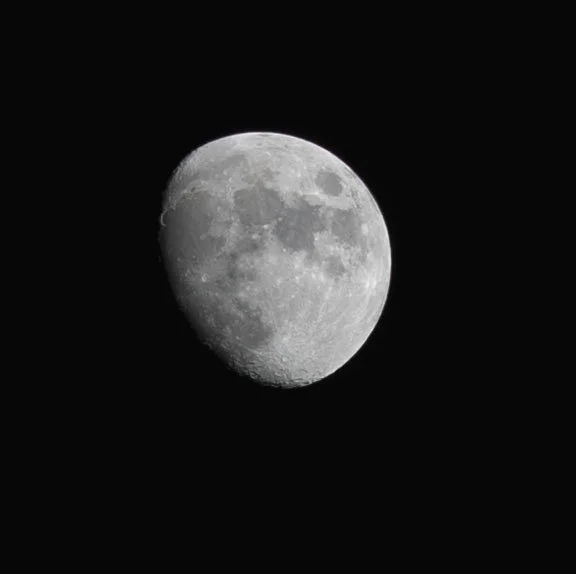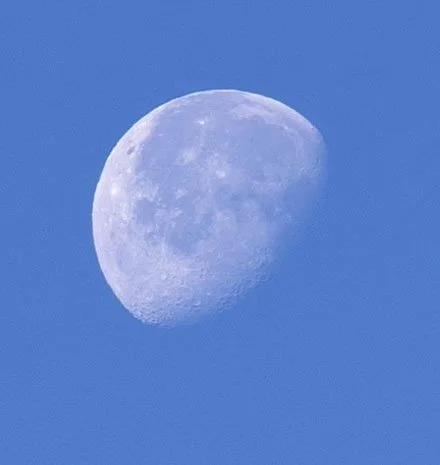The Moon
The Moon is the earths only natural satellite orbiting at an average distance of 238,900 mi (384,400 km) and an average speed of 0.635 mi/s (1.022 km/s).
Earth’s Moon is the only place beyond earth where humans have ever set foot.
The Dark Side of the Moon
As the moon flies through space at thousands of miles per hour, spinning around the Earth it actually doesn’t spin in one relative direction. The same side of the moon always faces the earth, hence the term the “dark side of the moon”. In reality, no part of the moon see’s less sun than another but due to a tidal dependence of the moon as it spins around the earth, the same side of the moon always faces the earth. The term “dark side of the moon” is actually a misnomer and instead is often refered to as the far side of the moon since it’s always facing away from the earth.
The Moon Phases
The phases of the moon are caused by the relative position of the Moon, the Sun and the Earth. Because the Moon produces no visible light of its own, we can only see the parts of the Moon that are lit up by other objects. A small amount of light comes from distant stars and the reflection of light from the Earth (known as Earthshine); however the main source of light is the Sun. At almost all times (with the exception of a lunar eclipse) half the moon is being lit up by the sun but we can only perceive part of the illuminated portion based on the angle the sun reflects off the moon and back to the earth.
You may also notice that the moonrise and moonset are constantly changing allowing us to sometimes see the moon during the day. Although the moon completes a full rotation around the earth in 27 days, the moonrise and moonset are actually due to the rotation of the earth, which is much faster than that of the moon.
Moon and Tides
Tides are caused by the gravitational forces of the moon. The moons gravitational pull causes the Earth to bulge (high tide) on the side closest and further from the moon making the best way to track the moons location in the sky by following the tides. Since high tides occur twice a day approximately every 12 hours and 24 minutes they are not fully synced with our clock system which is related to why we notice the position of the moon change in the sky overtime. The moon rises approximately 50 minutes later each day due to the difference in the earth’s rotation and the moons revolution which is in sync with two tides each day approximately 24 minutes later.
The Moon’s Orbit
The moon orbits the earth once every 27.32 days and rotates on its’ axis on the same schedule which scientists call synchronous rotation. As a result it appears, from Earth, as if the moon is not spinning allowing us to only see one side of the moon, the near side.
As the moon orbit’s the earth, its’ position in the sky (in relation to the sun) also changes. The moon appears “full” or fully lit on the near side when the Earth is located between the sun and the moon and the moon is at its’ furthest point from the sun. When the moon is full it rises at sunset and sets at sunrise. When the moon is between the sun and the Earth it appears “new” or completely dark and rises at sunrise and sets at sunset not allowing any night pictures of the true “new” moon.
The Future of Travel to the Moon (Artemis)
Artemis is a US led spaceflight program with the ultimate intention of establishing a presence for life on the moon. The program, which officially begin in December 2017 is designed with short and long term goals with the ultimate goal of establishing the foundations for extraction of moon resources and eventually making crewed missions to Mars and beyond.
The short term goal of the mission is to send humans back to the moon. The last lunar landing mission was Apollo 17 in 1972. The Artemis program is trying to change that with the first crewed test flight planned for 2024 and the first planned lunar landing for 2025. By 2026 they expect to be able to send a crewed mission to a Lunar Gateway station that will be launched and landed in a separate support mission.
The future of space travel and moon exploration is a daunting thought but the technological advancement of the 21st century have made this idea a real possibility opening new doors to the universe.





